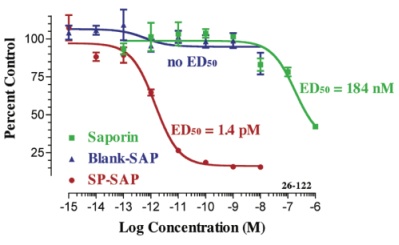One of the most important features of the Advanced Targeting Systems product line is the availability of control toxins that allow the researcher to fully evaluate results of the treatment of cells or animals with targeted toxins. For instance, anti-DBH-SAP is targeted with a mouse monoclonal antibody. Its control partner is mouse IgG-SAP, that is, mouse IgG that has no targeting properties. The difference in effect between these two shows the difference between targeted toxins and non-targeted.
Similarly, Blank-SAP is the appropriate control molecule for the peptide ligand-targeted toxins. Blank-SAP behaves as its name implies; you’re shooting blanks because the peptide sequence has no receptor, but the residues in the blank peptide contain the usual amino acids that are often found in ligand sequences.
These materials are provided at a nominal charge in targeted toxin kits. They are a great improvement, we believe, over using just plain saporin as control, or even saporin and its targeting vehicle added together, but not conjugated.
We have recently improved our control toxins by increasing the concentrations such that they are greater than the targeted toxin for which they act as a control. This was suggested to us by one of our clever clients, who asked for an increase in concentration, so that he would not be limited to the dose he used by the concentration of the control immunotoxins. For instance, if, for the ‘real’ toxin, 4 micrograms of a 2.5 micrograms per microliter concentration were to be injected, 1.6 microliters would be used. But if the control toxin were at a concentration less than 2.5 micrograms per microliter, the control would be injected in a greater volume (let’s say at 2 micrograms per microliter, you would need 2 microliters), which by itself could have an effect. Control toxins are now in the range of 4-5 micrograms per microliter so that they can be diluted to the same concentration as the targeted toxin. It’s part of our continuing effort to make ATS reagents more user-friendly for you.
Control Immunotoxins Available in targeted toxin kits or individually – see complete list here
| IT-21 | Blank-SAP | control for peptide-targeted toxins (SP-SAP, SSP-SAP, Orexin-SAP, Dermorphin-SAP, CRF-SAP, NPY-SAP, and CCK-SAP) |
| IT-19 | Goat IgG-SAP | control for goat IgG-targeted toxins (Mab-ZAP, Rab-ZAP, Hum-ZAP, Rat-ZAP, Anti-M-ZAP) |
| IT-18 | Mouse IgG-SAP | control for mouse IgG-targeted toxins (192-Saporin, OX7-SAP, Anti-DBH-SAP, ME20.4-SAP and Anti-SERT-SAP) |
| IT-17 | Rat IgG-SAP | control for rat IgG-targeted toxins (Mac-1-SAP and Anti-DAT-SAP) |

Mouse IgG-SAP. PC12 cells, a rat tumor cell line that expresses the Thy 1 receptor, were plated at 5000 cells per well in 90 microliters of medium. After allowing acclimatization overnight, the cells were exposed to the various reagents at the indicated concentrations for 72 hours. MTS (Promega) was added and after two hours, plates were read at 492 nM on a Molecular Diagnostics Spectramax 340 plate reader with SoftMax software. Data were analyzed by Prism 3.0 software.

Blank-SAP. KNRK cells expressing the substance P receptor (NK-1r) were plated at 2500 cells/well in a 96-well plate and incubated overnight at 37°C. The following morning, SP-SAP, unconjugated saporin, or Blank-SAP was added. Plates were incubated for 3 days before being developed with MTS (Promega). The ED50’s show that Blank-SAP has almost no activity in the tested concentration range.
